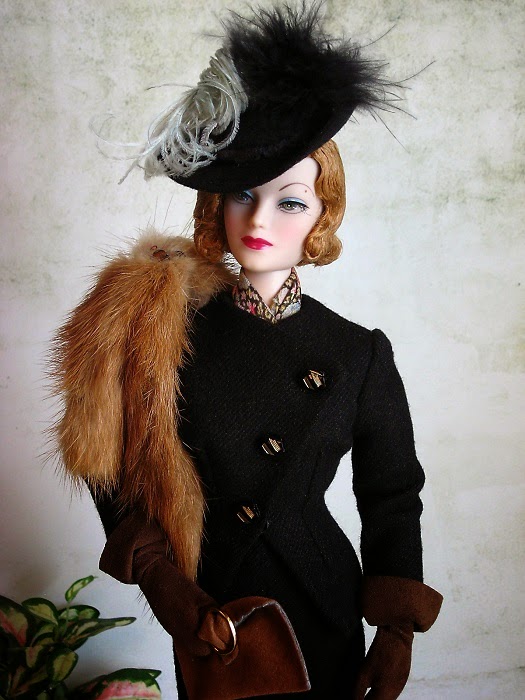From home decor to jewelry to clothing, upcycling is a hot trend today. The process of taking an old piece and updating it is certainly not new. Because of wartime supply shortages, women of the 1940's were encouraged to recycle items in their wardrobe. "Make Do and Mend for Victory" was the motto of the day.
Hats were a favorite item to renovate. You can give a tired, old hat a new lease on life by simply changing the trimming or reshaping it into a new style. So when your miniature diva is in need of a new chapeau, consider taking a hat she already owns and upcycle it into a brand new one.
The "fur" hat from Ashton Drake's "Goodbye New York" suit ensemble becomes a chic cocktail hat with a nod to the whimsical style of Balenciaga. The original "fur" trim was replaced with a single red rose and feather spray. Suit is from The Couture Touch, gloves are from Robert Tonner, and handbag is from Ashton Drake. "Cocoa Crisp" Gene Marshall is from Integrity.
The black felt hat from Ashton Drake's "Doing Her Part" suit ensemble begs to be dressed up. The original satin ribbon band was replaced with a black velvet one and feathers accent this smart topper. OOAK suit, scarf, and gloves are from The Couture Touch, fur is from miniature furrier PD Root, and handbag is from Ashton Drake. "C'est Moi" Madra Lord is from Integrity.
The straw hat from JamieShow's "White Orchid" Gene Marshall is reshaped into a dramatic tilt taking it from casual to daytime chic. A black bow and jersey bandeau accents this stylish look. Dress and gloves are from Ashton Drake, shrug is from Robert Tonner, ooak necklace and bracelet are from StrayCat, and purse is from PD Root. "Symphony in G" Gene Marshall, enhanced with an Integrity articulated body, is from Ashton Drake.
Reshaping Miss Marshall's Straw Hat
 |
| Photo courtesy JamieShow |
The hat from "White Orchid" Gene Marshall is made of pliable straw and was easy to reshape. As you will see in the following photos, the top of the original hat will become the underside of the new style. To begin, remove the original hatband.
Using my thumb, I gently pressed on one side of the crown to form a dent as shown in the above photo. The arrow indicates the new location of the back of the hat. The original red hatband left a slight mark on the straw so I covered it with a handmade paper label with the head-size. These labels were often found in vintage hats of the era. Once you are satisfied with the shape, flip your hat over. In the next two photos, you can see the finished shaping of the hat. All that is left to do is to apply the trimming. I used a pre-made bow that I recycled from another item.
 |
| Back-view |
 |
| Side-view |























